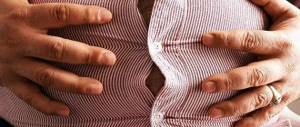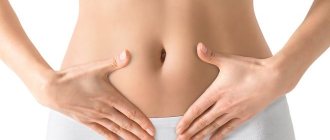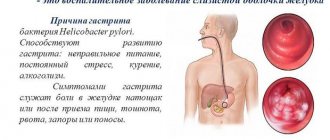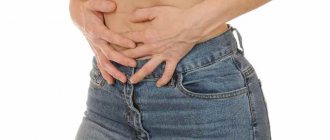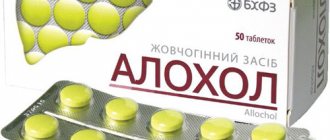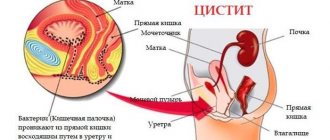Abdominal pain after eating can occur in children and adults, regardless of age. Due to the relatively large number of causes, abdominal pain often presents diagnostic difficulties for doctors. However, in their opinion, in most cases, abdominal pain after eating, both on the right and left sides, occurs due to digestive problems: poor digestion, poisoning or overeating. Slightly less common causes of abdominal pain are diseases of the gastrointestinal tract. Discomfort is often accompanied by a feeling of bloating, as well as oppression and heaviness in the abdomen.
Causes of intestinal pain after eating
There are a huge number of factors that cause pain in the abdominal area, and to determine which one is affecting a person’s well-being, you need to consult a doctor. Most often, the main factor causing pain in the intestines is the consumption of heavy and spicy foods, eating on the go, or dry food. Too cold or hot dishes affect your well-being, which irritate the walls of the mucous membrane of the digestive system, which causes malfunctions.
It also happens that the factor that causes abdominal pain may be a product that is not suitable for a particular person, and after taking it allergic reactions, fermentation and colic may occur. In this case, you need to identify such a product and exclude it from the diet. If the stomach hurts for no apparent reason, a person feels unwell, or has a fever, then in this case you need to consult a doctor, as this may be inflammation of appendicitis, which, if not treated in a timely manner, will cause a serious complication.
Causes of pain in the anus
The causes of discomfort in the sphincter area and lower intestine can be either local or general.
Various problems in the body affect the blood supply to the intestines, the elasticity and strength of the walls of blood vessels, the secretory function of the glands, and the process of defecation.
List of diagnoses that cause pain in the anus:
- hemorrhoids - varicose venous plexuses located in the walls of the rectum with the formation of nodes;
Proctitis is an inflammatory disease affecting the mucous membrane of the rectal wall
Picture of anal fissure
Both men and women are equally susceptible to the disease, and about 15 out of 100 people suffer from this disease.
Haemorrhoids
Causes of hemorrhoids:
- bearing a child and childbirth, during which all organs are compressed and the blood supply to the pelvis is disrupted;
- constipation, which leads to increased pressure in the intestines and increased blood flow;
- abuse of spicy foods, which irritate the anal area;
- infection due to poor hygiene.
Causes of hemorrhoids in women
First there is itching and burning. Then, severe pain and bleeding sequentially occur, and the hemorrhoids eventually fall out.
Clinical manifestation of hemorrhoids
It is better to start treatment at the first symptoms, especially since they can be harbingers of colon cancer.
Hemorrhoids can be located externally or internally, and can also be hereditary or acquired.
In the absence of proper treatment, consequences such as:
- swelling of the anus;
- inflammation of the fatty tissue of the intestine with the formation of pus;
- tissue death of hemorrhoids.
Thrombosis of hemorrhoids
Thrombosis of hemorrhoids is one of the complications of hemorrhoids. If there is a disturbance in the inflow or outflow of blood through the veins, cavernous tissue begins to grow, which, in turn, forms nodes.
A distinction is made between internal and external thrombosis based on the location of the nodes.
Characteristic symptoms:
- constant dull pain in the intestines, independent of bowel movements;
- sensation of the presence of a foreign object in the intestine;
- high body temperature;
- weakness;
- discomfort in the perineum;
- nausea.
Subsequently, the nodes become inflamed, and the temperature of the skin around the anus rises sharply.
Thrombosis of hemorrhoids
Rectal prolapse
Prolapse of the rectum (rectal prolapse) is a violation of its anatomically correct position with extension beyond the anal sphincter.
Forms of rectal prolapse
- violation of the anatomy of the pelvic bones;
- deformation of the pelvic floor muscles;
- excessive physical stress, which increases intra-abdominal pressure;
- various injuries to the sacrum and lumbar region;
- neoplasms in the rectum;
- urolithiasis disease;
- inflammation of the prostate in men;
- multiple or difficult births in women.
Causes of rectal prolapse
- pain;
- inability to contain bowel contents;
- frequent, but false desire to defecate;
- bleeding;
- secretion of mucus from the intestines;
- feeling of the presence of a foreign object in the anus.
Features of the condition
If a person begins to have a stomach ache immediately after eating, this may be an indication that they are developing a stomach ulcer. The fact is that when food enters the stomach, hydrochloric acid begins to be released, which inflames and corrodes the mucous walls of the organ, resulting in painful sensations. 1.5-2 hours after eating, the pain goes away as the secretion level drops. If this happens regularly, and changing your diet and sticking to a regimen does not help, then you should not hesitate, but urgently seek medical help. A chronic ulcer or gastritis, if not treated correctly, can subsequently become the root cause of a malignant neoplasm.
Connection with nutrition
If pain in the intestines is directly related to eating food and occurs immediately after eating it, then in this case they can occur for the following reasons: eating food that irritates the mucous membrane and loads the stomach. There may be pain that occurs due to the fact that a person has not eaten on time, in this case they go away as soon as the patient has eaten. If painful sensations occur in the middle of the night and are difficult to get rid of, this often indicates that the person has an ulcer. If the pain is constant and regular, this is evidence that pathologies are occurring in the intestines that require urgent identification and treatment.
Pain when pressing
If pain occurs as a result of pressure, then this indicates the possible presence of an ailment such as appendicitis, gastritis, which has a chronic form, duodenal ulcer, or the presence of a neoplasm, often of malignant origin. You should be wary when abdominal pain is accompanied by a rise in temperature, which is difficult to bring down; most often this is a sign that appendicitis has become inflamed in the body.
Stomach ulcer and pain
If a person has a stomach ulcer, then in this case the source of pain is concentrated in the center of the abdomen, and the pain can run both to the right and to the left. The pain syndrome appears after eating, when the acid reaches its maximum level. More often, with peptic ulcers, the disease worsens and worries in the fall and spring, when the body is subject to the greatest stress. In addition to painful sensations, evidence that a person has a stomach ulcer is:
- constant attacks of nausea and vomiting;
- heartburn, which occurs every time the patient has eaten, and attacks of reflux with a sour, cutting taste also occur;
- a person may develop an aversion to certain types of foods;
- after eating, heaviness appears in the stomach, the intestines seem to swell, colic may bother you;
- lack of appetite, which leads to the patient rapidly losing weight.
Return to contents
Why does discomfort occur?
First of all, it varies in intensity. Sometimes there is an impression of the presence of a small foreign body, a nodule. Burning and itching of a periodic or constant nature may also be noted. The most alarming symptom is pain, especially if it occurs frequently, accompanied by the release of scarlet blood during bowel movements. The general classification of reasons is as follows:
- Lesions of the rectum. In this case, pain in this area is caused by hemorrhoids, prolapse, the appearance of polyps, condylomas, proctitis, anal fissures;
- Inflammatory processes in the subcutaneous tissue. These include fistulas, paraproctitis, coccydynia (or epithelial coccygeal tract);
- Malignant neoplasms in the intestines;
- Irritation or inflammation of the skin of the perineum;
- Some helminthic infestations.
Important to remember! Specific inflammation of the prostate gland in men or the vagina in women does not directly affect the rectal area. However, pain is also felt in the rectum, and usually has the character of a lumbago - a sharp, sudden and acute attack.
How to treat?
To find out the root cause of why the stomach or intestines hurt, you need to contact a gastroenterologist, who will refer you to the appropriate diagnostic measures, and as soon as it becomes known what is the root cause of the disease, special treatment is prescribed. If you urgently need to relieve pain and spasms, No-Shpa tablets can help, they block spasms and help temporarily get rid of pain. However, this is only temporary therapy and first aid. “No-Spa” does not treat the root cause, and as soon as the effect of the medicine wears off, the pain will make itself felt again.
Massaging the abdomen in a clockwise direction will help relieve spasms.
Special massage movements can help overcome pain spasms. To do this, you need to lie in a comfortable position and make circular stroking movements of the abdomen in a clockwise direction. After a short period of time, the spasms subside and the pain goes away. If a person is diagnosed with a stomach ulcer, then in this case a glass of warm milk, which has astringent properties and helps reduce acidity, which in case of an ulcer is most often the cause of abdominal pain, will help get rid of abdominal pain.
THIS IS REALLY IMPORTANT! The gastrointestinal tract cannot be neglected - this risks cancer. Cheap product No. 1 against stomach pain. FIND OUT >>
For high acidity, the doctor prescribes antacid medications that have anti-inflammatory, astringent and analgesic properties. Almagel, Maalox, Phosphalugel, Gastal, Gaviscon and others have proven themselves well. They are universal in use, effectively help eliminate the disease, and have almost no contraindications. However, in no case should you prescribe this or that medicine yourself, as this can cause complications, which are then much more difficult to treat.
Prevention
If the reason why the stomach and intestines hurt is identified, then in this case, in addition to drug therapy, the doctor will suggest that the patient follow preventive measures that will help prevent relapse and relieve discomfort and pain for a long time. First of all, prevention consists of adhering to the rules of a therapeutic diet, which excludes from the patient’s diet foods that negatively affect the gastric mucosa, irritate it and prevent the healing of wounds and erosions.
You need to adhere to a daily routine and diet, eat food at a certain time, chewing every bite thoroughly. Food should not be too hot or cold, because this also negatively affects the functioning of the digestive system. During preventive measures to heal the intestines and stomach, in consultation with your doctor, you can choose medicinal mineral water for yourself, which will help cure pathologies of the gastrointestinal tract.
Don’t forget about physical therapy, which will help a person feel good and eliminate unpleasant discomfort in the stomach. However, it must be remembered that incorrectly selected exercises can harm the patient and worsen their well-being. If you turn to a trainer for help, you need to notify him about what disease you have so that all points are taken into account.
Abdominal pain after eating is a pathological condition that may be a consequence of a disease. Anyone can face the problem - the anomaly has no restrictions regarding gender and age category.
The most common causes of pain after eating are physiological factors, such as intolerance or consumption of low-quality foods. Some gastrointestinal diseases can be sources of the disorder.
Pain in the abdomen after a meal in a child or adult is often accompanied by a large number of other symptoms: nausea and vomiting, flatulence, upset stool, rumbling in the intestines.
It is impossible to determine the etiological factor without laboratory and instrumental examinations. A thorough physical examination is important in the diagnostic process.
Abdominal pain after eating can be relieved using conservative therapeutic methods. Treatment of the underlying disease can be complex.
Causes
Unpleasant sensations in the stomach appear as a result of digestive disorders, which is caused by a deterioration in the depository, motor, secretory, evacuation, excretory, absorption, endocrine or protective functions.
Secretion disorder
With secretory dysfunction, a qualitative or quantitative change in gastric juice occurs, which disrupts its ability to digest food. If the amount of gastric juice secreted differs from normal, then they speak of hyposecretion or hypersecretion.
These disorders are not always a consequence of a stomach disease; in some cases, the cause is a deterioration in the functioning of the nervous, urinary or endocrine systems. Qualitative changes are manifested in the concentration of hydrochloric acid (probably a decrease, increase and absence of hydrochloric acid).
With hypersecretion, a lot of hydrochloric acid and pepsinogens are released, which leads to an increase in the digestive ability of the juice. The pathology develops against the background of the use of certain medications (glucocorticoids, salicylates) and gastrointestinal pathologies (peptic ulcer, hypertrophic and erosive gastritis).
With hypersecretion, acid is present in the stomach even in the morning on an empty stomach, although normally only traces of it should be detected. The disorder manifests itself as pain in the upper abdomen, heartburn, sour belching, a feeling of pressure and fullness, vomiting, nausea, worsening evacuation of chyme into the intestines (after eating, discomfort in the stomach lasts a long time).
With hyposecretion, the production of gastric juice and pepsinogen is reduced or absent, so food is digested slowly or not at all. Pathology develops with anorexia, chronic infectious-toxic processes, tumors in the stomach, atrophic gastritis, lack of vitamins (C, E, B), as well as electrolytes, water or complete proteins.
Hyposecretion is clinically manifested by dyspeptic symptoms, decreased digestion speed and deterioration of gastric motility, increased fermentation and putrefaction, dysbacteriosis, and diarrhea.
Motor dysfunction
When gastric motility is impaired, peristalsis and muscle tone of the organ changes, the evacuation of chyme is disrupted, which is why heartburn, vomiting, belching, and pylorospasm occur. With hypertonicity, pain appears in the epigastric region, increased peristalsis of the stomach, the contents of the organ move more slowly into the small intestine, which leads to frequent sour belches and vomiting.
Hypotonia develops against the background of stress, infections, neuroses, hypoacidity or pain. It manifests itself as heaviness and a feeling of fullness in the area of the xiphoid process, nausea, since rotting and fermentation in the stomach is increased due to the weak evacuation ability.
Hyperkinesis (excessive physical activity), among other things, is provoked by rough, plentiful food rich in cellulose and proteins, and alcohol. On the contrary, hypokinesis (lack of motor activity) of the stomach occurs if a person eats delicate foods for a long time, poor in fiber, vitamins and proteins, but rich in carbohydrates and fats, and also if he drinks a lot of water before and after meals.
Hypertonicity and hyperkinesis of the stomach often causes pylorospasm, vomiting and nausea. Hypotonicity of the esophageal sphincter leads to belching; if the activity of the stomach muscles is increased, then severe heartburn appears.
Enzyme deficiency
Enzyme deficiency occurs due to limited secretion or insufficient activity of pancreatic enzymes, which leads to impaired breakdown and absorption of nutrients.
The pathology can be primary (the pancreas is affected, causing its exocrine function to be impaired) and secondary (enzymes are synthesized, but are inactivated or not activated in the small intestine). The disease is manifested by increased gas formation, anemia, steatorrhea, diarrhea, lack of vitamins, and progressive weight loss.
Against the background of impaired gastric motility, nausea, heartburn, vomiting, and a feeling of fullness of the organ occur.
Due to a lack of lactase, lactase deficiency develops. During the disease, milk sugar (lactose) is not broken down, that is, milk and products made from it are not digested. Lactose must be broken down in the small intestine and converted into glucose and galactose, which can enter the bloodstream.
With lactase deficiency, milk sugar cannot be broken down, which means it penetrates into the large intestine, where it begins to ferment, which causes increased acidity, excessive gas formation and water secretion. In addition to abdominal discomfort, after drinking milk, patients complain of diarrhea or constipation, flatulence, and sleep disturbance.
With a deficiency of the enzyme that breaks down gluten, celiac disease develops, which is characterized by chronic inflammation of the small intestinal mucosa and impaired absorption function. Gluten contains a substance that is toxic to the intestinal mucosa and causes its atrophy. Celiac disease provokes the occurrence of diarrhea, steatorrhea, and polyhypovitaminosis.
Discomfort in the stomach appears after eating foods containing gluten (bread made from wheat, barley, oat, rye flour, pasta, semolina, beer, kvass; traces of gluten are found in chocolate, ice cream, cocoa, instant coffee, sausages, sausages, canned food ).
Enzyme deficiency can be diagnosed in childhood, but can also manifest itself in an adult. For example, a decrease in lactase levels begins as early as 3-5 years, so some people already in adulthood find that after drinking milk, which they previously tolerated well, abdominal discomfort begins.
Poor nutrition
Often the cause of stomach discomfort is the lack of a meal schedule, overeating and eating unhealthy foods. If you skip meals for a long time or even periodically, and then eat your fill, if you give preference to fatty, fried, spicy foods, if you combine incompatible foods, then it is difficult for the stomach to digest food due to the inability to synthesize the required amount of gastric juice and enzymes.
As a result, food does not leave the stomach for a long time and begins to ferment, causing bloating, belching, and nausea.
If gas formation in the stomach is increased, the air causes the walls of the organ to expand, and this causes discomfort.
When creating a menu, it is also necessary to take into account the compatibility of products, since different products require different enzymes and different amounts of gastric juice. Nutritionists identify six groups of substances (proteins, fats, carbohydrates, acids, sugars, starches), which behave differently when digested.
For example, an acidic environment is required for the breakdown of proteins, and an alkaline environment is required for carbohydrates, and if they simultaneously enter the stomach, the digestion of food slows down and discomfort in the stomach occurs. Long-term adherence to diets that limit the consumption of protein, fat or carbohydrates also has a negative impact on digestion.
For the normal functioning of the entire body, all these substances are required in a certain ratio. If you eat a lot of protein foods, rotting processes begin to actively occur in the stomach and intestines, putrefactive bacteria multiply, which are the cause of dysbiosis. When you eat predominantly carbohydrate foods, fermentation begins in the intestines. Fatty foods contribute to obesity.
Etiology
The pathogenesis of abdominal pain after a meal is that food passes through the esophagus and reaches the stomach, which increases in size and begins to secrete gastric juice. Active contractions begin, and food enters the duodenum.
If at any stage a digestive disorder occurs, a person experiences pain in the area of the anterior wall of the abdominal cavity. Unpleasant sensations are formed against the background of the influence of digested food and digestive juices on the damaged membrane.
The most common abdominal pain after eating is the consequences of poor nutrition:
- eating food immediately before bedtime;
- dry food;
- eating “on the run”;
- lack of a meal plan - it is better to eat every day at the same time;
- eating spicy, sour and overly seasoned foods;
- prolonged refusal to eat followed by overeating;
- insufficient amount of food consumed;
- ingestion of excessively dry food;
- eating high protein foods.
Lactose intolerance can cause severe abdominal pain. Allergies to the following foods can cause illness:
- eggs;
- milk products;
- cocoa and chocolate;
- nuts;
- Fish and seafood;
- citrus;
- honey;
- strawberries and wild strawberries;
- flour and pasta;
- soybeans, beans and other legumes.
It is worth noting that food allergies are the most common cause of abdominal pain after eating in a child.
The causes of abdominal pain after eating can be pathological. The underlying disease may be:
The anomaly may appear due to a disease that is not associated with the digestive system:
- fractures of the lower ribs;
- sternum injury;
- pleurisy;
- myocardial infarction;
- purulent form of sore throat or pneumonia;
- inflammation of the reproductive organs in women;
- rupture of aortic aneurysm;
- ketoacidosis.
The reason why your stomach hurts after a meal may be indicated by the nature of the pain. For example, long-term nagging pain occurs as a result of such pathologies:
Burning pain can be caused by ingestion of sour or salty foods, the development of gastritis or pancreatitis.
Sharp abdominal pain immediately after eating appears in the following situations:
- consumption of low-quality products;
- inflammation of the appendix;
- open stomach ulcer;
- acute food poisoning;
- the course of infectious processes;
- exacerbation of gastritis;
- pancreatitis.
The etiological factor can be indicated by the localization of pain:
- pain in the upper abdomen or in the navel area occurs due to inflammatory damage to the stomach or duodenum;
- in the iliac zone with irradiation to the right hypochondrium they speak of cholelithiasis, inflammation of the bile ducts or gallbladder;
- “in the pit of the stomach” and under the ribs is a sign of an ulcer of the duodenum or stomach.
It is noteworthy that if the pain appears immediately after a meal or after about an hour, the problem lies in the esophagus or stomach, and if the pain occurs after 2 hours or more, the cause of the abnormality is in the intestines.
Abdominal pain after eating while carrying a child is most often associated with displacement of organs located in the abdominal cavity. Filling the stomach causes them to compress, causing aching pain.
Pathologies and diseases that cause abdominal pain after eating
According to statistics, any major holidays invariably end with some kind of epidemic of inflammatory processes in the pancreas or gall bladder. Even people who do not suffer from diseases, if they consume too much fatty foods, and even wash them down with alcoholic drinks, can experience pain in the abdominal cavity.
Such pains usually occur after overeating and disappear when the diet is normalized. It’s another matter if they appear regularly and when eating standard portions of food. In this case, it is recommended to visit a doctor and determine the pathology that causes discomfort. The main reasons why your stomach hurts after eating are:
- food poisoning;
- food allergies;
- enzyme enteropathy;
- pancreatitis;
- cholecystitis.
Food poisoning
If your stomach hurts and you feel nauseous after eating, then the cause of the discomfort may be poisoning by some food. On average, pain appears 2-4 hours after dinner or lunch. Initially, a person feels heaviness in the epigastrium, and then the poisoning is complemented by other symptoms:
- nausea and vomiting;
- diffuse pain, sometimes in the form of contractions;
- loose stools;
- fever, chills;
- intoxication (general weakness, headache or dizziness).
Food allergies
If a person is allergic to certain foods, then after taking them they may experience discomfort. With food allergies, it usually hurts in the navel area, and the pain is stabbing, aching or spasmodic in nature. Sometimes additional signs of an allergic reaction appear, such as itchy skin rashes, diarrhea or constipation.
Important! Allergies can lead to dangerous complications such as anaphylactic shock or Quincke's edema, so if it manifests itself, it is necessary to visit a doctor.
Enzyme enteropathy
If there are pathologies of the enzyme system, a person may not tolerate certain types of food. Most often, people experience milk intolerance. When consumed, enzymatic enteropathy develops, which is characterized by pain, flatulence, and diarrhea. If you continue to take dairy products, then over time, malabsorption syndrome may develop, when the intestinal absorption of nutrients is impaired.
Pancreatitis
Pain in the upper abdomen after eating often indicates problems with the pancreas. In acute pancreatitis that occurs after overeating, the pain is localized in the epigastrium and radiates to the neck, back, between the shoulder blades or the lower part of the face. It usually appears 3–5 hours after eating or at night if sleep was preceded by a large evening meal.
If a person suffers from chronic pancreatitis, then the pain may bother you for a long time. As a result, the patient tries to eat less, which is why he loses a lot of weight. A characteristic sign of the disease is fatty stool, which has a mushy consistency and contains undigested pieces of food.
Acute cholecystitis
The appearance of sharp pain sometimes indicates acute cholecystitis. The pain syndrome occurs in the right side of the abdomen and worries mainly at night. It is most often caused by excessive consumption of fatty foods. In addition to abdominal pain and nausea after eating, vomiting occurs. From the very beginning of the disease, a strong increase in temperature is possible, up to 40 degrees.
Other reasons
Among the additional factors contributing to pain, the following pathologies are considered:
- enteritis;
- abdominal toad;
- colitis;
- irritable bowel syndrome;
- diseases of the duodenum, stomach;
- dysbiosis.
Symptoms
The symptomatic picture of the disorder includes many other clinical manifestations. It is extremely rare that pain will act as the only external sign of illness. The clinic is of a purely individual nature, which is determined by the influence of one or another etiological factor.
Soreness can be of a different nature:
- pricking;
- blunt;
- cutting;
- shooting;
- intense or weak;
- aching or sharp;
- moderate or cramping.
In most situations, pain in the lower abdomen after eating is accompanied by the following symptoms:
- increase in temperature indicators;
- constant nausea ending in vomiting;
- feeling of abdominal distension;
- problems with bowel movements;
- the presence of blood, mucus or pus in the feces;
- weakness and general malaise;
- flatulence;
- fast fatiguability;
- bloating;
- heartburn and belching with an unpleasant odor;
- bad breath;
- difficulty swallowing solid food;
- increased sweating;
- the skin becomes pale or yellow (with liver damage);
- rumbling in the stomach;
- heaviness and fullness of the stomach;
- decreased or complete lack of appetite;
- white or yellow coating on the tongue;
- decreased ability to work;
- rumbling in the intestines;
- weight loss;
- attacks of headache and dizziness;
- sleep disorder;
- hiccups;
- emotional instability.
Diagnostics
Only a gastroenterologist can find out the causes of pain after eating in a child or adult and prescribe the most effective treatment.
Given the existence of a wide variety of predisposing factors, the process of making a correct diagnosis should only take an integrated approach. The first stage of diagnosis consists of manipulations that are performed directly by the clinician:
- familiarization with the medical history - to determine the influence of the pathological factor;
- study of life history - to clarify the impact of predisposing sources that have a physiological basis;
- deep palpation and tapping of the anterior wall of the peritoneum;
- measuring temperature and pulse, heart rate and blood tone;
- a detailed survey of the patient will enable the doctor to draw up a complete symptomatic picture, determine the location and nature of the pain, which may indicate an underlying disease.
- general clinical blood test;
- microscopic examination of feces;
- bacterial tests;
- immunological tests;
- PCR diagnostics;
- blood biochemistry.
The following instrumental procedures can accurately determine the etiological factor that provokes the appearance of pain in the abdomen after eating:
- gastroscopy;
- X-ray of the gastrointestinal tract with contrast agent;
- ultrasonography of the abdominal organs;
- colonoscopy;
- sigmoidoscopy;
- endoscopic biopsy;
- FEGDS;
- CT and MRI.
In some cases, malaise may be the result of pathologies not related to the digestive system, so the gastroenterologist refers the patient for additional examination to specialists from other fields of medicine, for example, a cardiologist or pulmonologist.
Treatment
When a person experiences abdominal pain, nausea and vomiting after eating, conservative therapeutic methods are used to eliminate them. The attending physician individually, based on the underlying disease, general condition, severity of illness and age of the patient, will formulate the most effective treatment tactics:
- use of medications;
- diet therapy;
- a course of therapeutic exercises;
- hardware, manual or water massage of the abdomen;
- alternative medicine.
In most cases, patients are prescribed:
- antibacterial agents;
- analgesics and antispasmodics - for pain relief;
- NSAIDs;
- immunomodulators;
- medications to eliminate associated symptoms, such as constipation and diarrhea, nausea and vomiting, bloating and flatulence, high fever, etc.;
- mineral and vitamin complexes.
The most effective medicines:
Treatment with physiotherapy is no less effective:
- ultrasound;
- electrophoresis;
- phonophoresis;
- warming up;
- acupuncture;
- magnetic therapy;
- darsonvalization;
- UHF;
- inductothermy;
- Diadynamic therapy.
It is not prohibited to use traditional medicine after consulting a doctor. At home, you can prepare medicinal drinks intended for oral administration based on the following ingredients:
- rowan and blueberry berries;
- horsetail;
- plantain;
- calendula;
- burdock;
- Melissa;
- mint;
- buckthorn;
- rose petals;
- St. John's wort;
- sagebrush;
- cottonweed;
- Linden;
- nettle;
- flax and dill seeds;
- rose hip;
- yarrow;
- chamomile;
- valerian.
It is impossible to completely get rid of abdominal pain after a meal without treating the underlying pathology.
Prevention and prognosis
To date, there are no specially designed preventive measures to prevent abdominal pain after breakfast or other food consumption.
The likelihood of illness can be reduced by following these simple rules:
- complete renunciation of addictions;
- maintaining a moderately active lifestyle;
- proper and nutritious nutrition;
- constant increase in immune resistance;
- body weight control;
- avoiding emotional exhaustion;
- taking medications strictly as prescribed by the clinician;
- early identification and treatment of any disorders that may lead to pain.
Do not forget about regular preventive examinations in a medical institution with visits not only to a gastroenterologist, but also to other doctors at least 2 times a year.
Abdominal pain after a meal can easily be treated with conservative therapy; patients often have a favorable prognosis. Ignoring or eliminating pain on your own can aggravate the problem, and refusing medical help will inevitably cause the progression of the underlying disease. The combination of such oversights is dangerous with negative consequences, even death.
Pain in the intestines after eating is a characteristic symptom of some diseases of the large and small intestines.
It is not food that causes pain, but a spasm of the muscles that make up the intestinal wall. The spasm begins under the influence of toxins or other damaging factors.
You will find out what the causes of pain are and what to do in such cases by reading the article to the end.
Causes of pain after eating
The intestines can hurt for a number of reasons. The most common source of pain is inflammation of the colon, rectum or cecum.
The sigmoid colon may become inflamed (sigmoiditis). However, in all these cases, intestinal discomfort is unrelated or weakly related to food.
Pain after eating occurs due to inflammation of the small intestine and transverse colon.
With inflammation of the small intestine, pain begins immediately after eating. The pain is pressing, widespread throughout the abdominal area.
With enteritis after eating, not only pain occurs, but also a feeling of severe distension of the intestines.
Inflammation of the transverse colon is also called ischemic colitis. With this disease, pain occurs 15–20 minutes after eating and subsides after a few hours.
The pain is localized in the left half of the abdomen. It is not strong, appears abruptly and stops just as abruptly.
The intensity of the pain is so insignificant that patients even forget to report this symptom to the doctor.
Common causes of pain are various parasitic infestations. Round and flatworms and Giardia can live in the intestines.
Pain begins when parasites mechanically act on the intestinal walls or secrete products that irritate the epithelium.
Dysbacteriosis is another pathology that causes pain associated with eating. Dysbacteriosis is a disturbance in the composition of the intestinal microflora.
The causes of dysbiosis may be different, but the consequence will always be indigestion and severe gas formation that begins after eating.
Useful tips
Every effort should be made to restore the normal functioning of the digestive system and look at your lifestyle from a different perspective.
What can help2:
- Stable daily routine and food intake. Normalizing biological rhythms helps the body get used to the timely production of enzymes for digesting food.
- Fractional meals - eating small portions up to 5 times a day to prevent overeating and maintain a routine. You can carry a snack in the form of nuts and dried fruits with you so as not to buy confectionery.
- Chewing thoroughly and eating in moderation.
- Balanced food composition. Particular attention should be paid to the composition of ingredients when purchasing ready-made dishes.
- Sufficient amount of water. Drink 1 glass of warm water 20 minutes before meals to reduce appetite.
- Minimum daily physical activity. You can replace taking the elevator with a walk up the stairs, or try to walk more.
- Eliminate bad habits such as alcohol and smoking.
It’s not easy to follow all the recommendations at once. And the effect of their use will not be noticeable immediately.
Poor nutrition causes abdominal discomfort
The causes of pain in the intestines may be associated not with pathologies of the gastrointestinal tract, but with food. Errors in nutrition greatly affect the condition of the digestive tract.
A meal that is too late, a dish that is too fatty, food that is dry, or poor chewing of food introduces an imbalance in the digestive processes and can cause pain in any part of the intestine.
Abdominal discomfort may begin after consuming specific foods: milk, brown bread, alcoholic beverages.
Food allergies can be a cause for discomfort. Most often, allergies begin after consuming milk, egg whites, or seafood.
There are allergies to cereals: wheat and rye - such people have to follow a gluten-free diet.
Poor nutrition can cause pain in the intestines not directly, but indirectly when it causes constipation. Difficulty defecating causes a feeling of distension in the intestines.
Constipation itself does not cause pain, but it can be caused by gases that fill the blocked intestines.
The entry of a new portion of food into the stomach and then into the intestines causes increased gas formation.
The pain in this case can be quite sharp. It radiates to the left hypochondrium and forces the person to assume a horizontal position.
A common cause of discomfort after eating is irritable bowel syndrome. IBS is the most common intestinal disease in the world, affecting 30% of people.
The disease is expressed in the fact that immediately after eating, without any reason, abdominal discomfort and diarrhea begin.
IBS is not dangerous to life or health, but it causes a lot of inconvenience. People with this disease know all the toilets in the area, since an attack can start at any time.
Stomach pain and diarrhea can plague everyone from time to time, but that doesn't mean everyone has IBS.
The doctor will make such a diagnosis if these symptoms have plagued the person for three months.
Why does IBS start? Its causes are mental disorders, overwork, and inappropriate food.
Pain in IBS occurs in the left side of the abdomen, but can also be of uncertain localization. As a rule, they decrease after bowel movements and become stronger after eating.
You can relieve pain with antispasmodics. In women with IBS, discomfort in the intestines becomes stronger in the first days of the cycle, during monthly bleeding from the uterus.
A distinctive feature of IBS will be the absence of pain in the intestines at night when the person is sleeping.
Discomfort in the intestines, bloating, causes
Symptoms: discomfort after eating, heaviness in the abdomen, heaviness after eating, abdominal pain, abdominal pain, stomach pain, epigastric pain, burning in the abdomen, burning in the stomach, bloating, intestinal upset, bloating, intestinal discomfort , frequent bowel movements, frequent urge to stool, indigestion, diarrhea (diarrhea), constipation, stool retention, abdominal distension, flatulence, gases in the intestines, heartburn, belching after eating, food intolerance, bitter taste in the mouth, dry mouth.
Disorders of the gastrointestinal tract, or digestive problems, are manifested by various symptoms: constipation, diarrhea, flatulence, pain, stinging, a burning sensation or heaviness in the abdomen, discomfort in the intestines, as well as heartburn, belching and unpleasant sensations in the mouth (dryness, bitterness). Quite often, symptoms may worsen immediately after eating. Disorders of the gastrointestinal tract may be accompanied by deterioration of appetite, general weakness and irritability.
Defecation with such disorders always brings noticeable discomfort: starting with pain in the abdomen and sensations of bloating, it occurs either too slowly and difficultly (with constipation), or, conversely, too often, and the stool has a liquid consistency (with diarrhea). In both cases, increased gas formation (flatulence) is observed.
Gastrointestinal disorders can be caused by disturbances in the functioning of the vegetative centers responsible for the functioning of the digestive organs. In such cases, diets and standard drug treatment for gastritis, dysbiosis and other diseases of the digestive system remain ineffective. Gastroenterological studies do not reveal serious problems, and the patient continues to suffer from the inability to eat and go to the toilet calmly. In this case, the patient is recommended to check the autonomic nervous system of the body. When the functioning of the affected vegetative centers is restored, the digestive process normalizes independently.
